#it's a Taisho period kimono
Text
I've done Sumiko
I've done Inoko
Now make way for Zenko!!!!
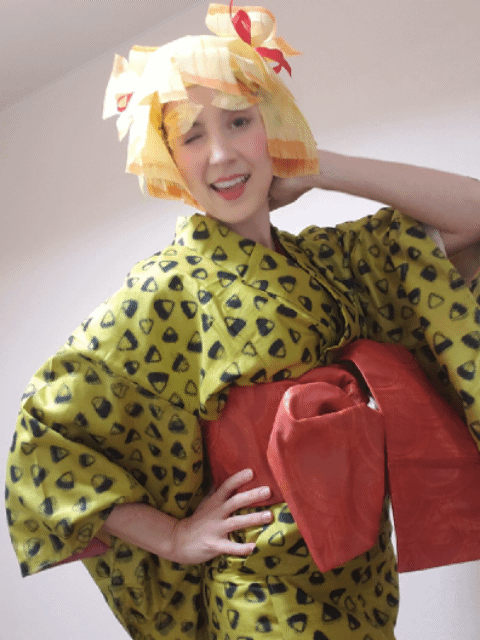
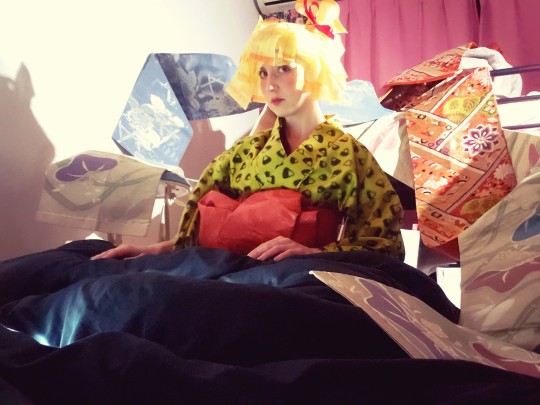
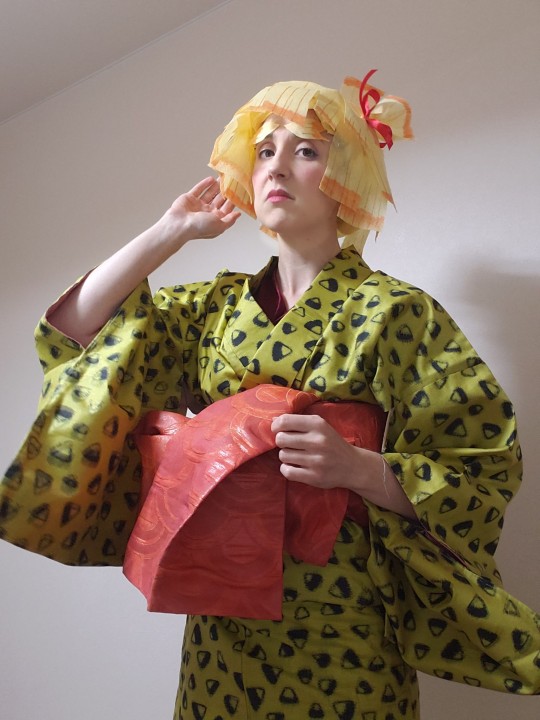
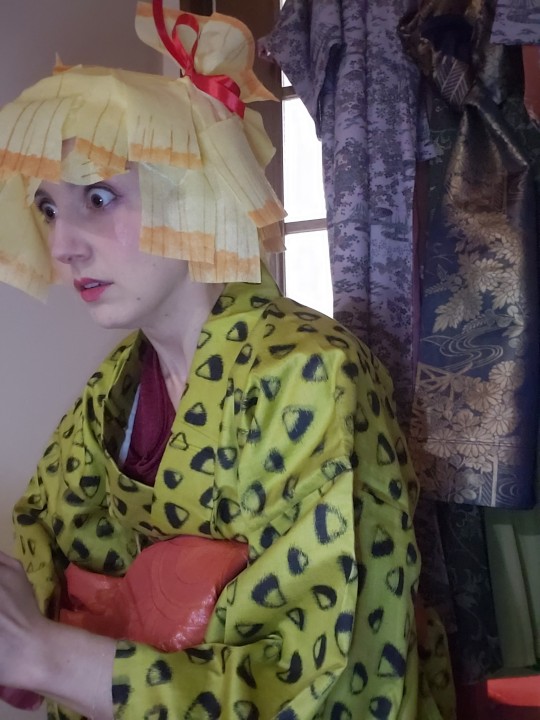

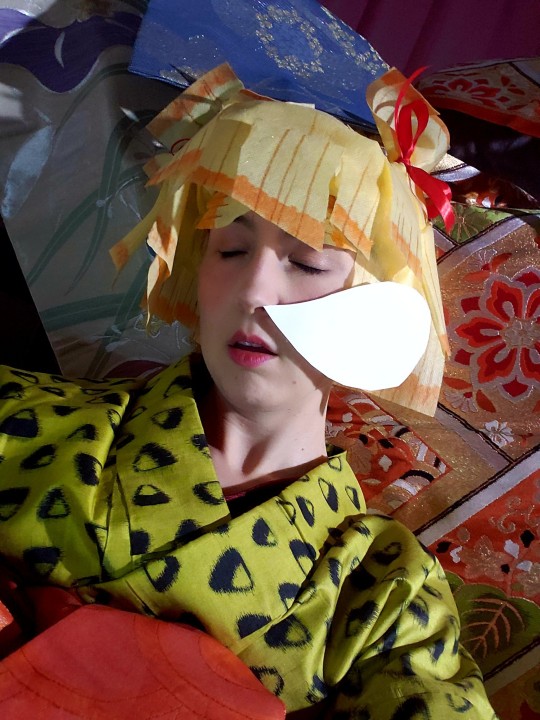
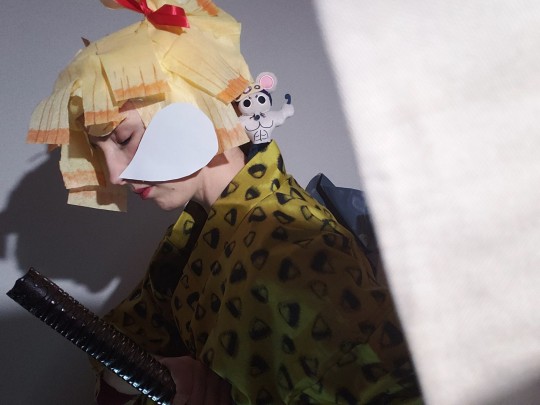
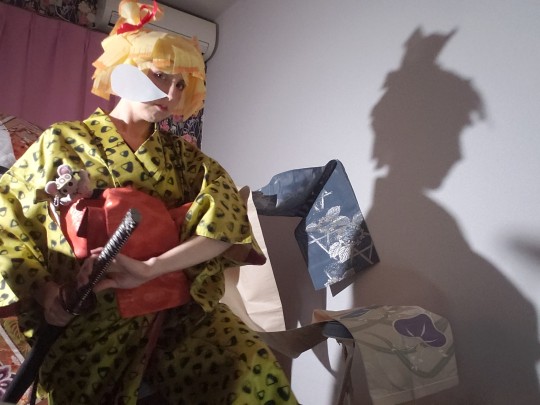
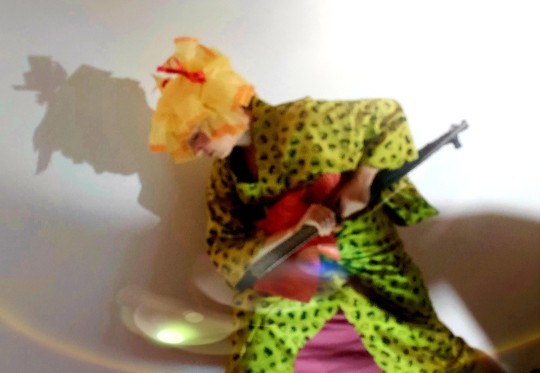
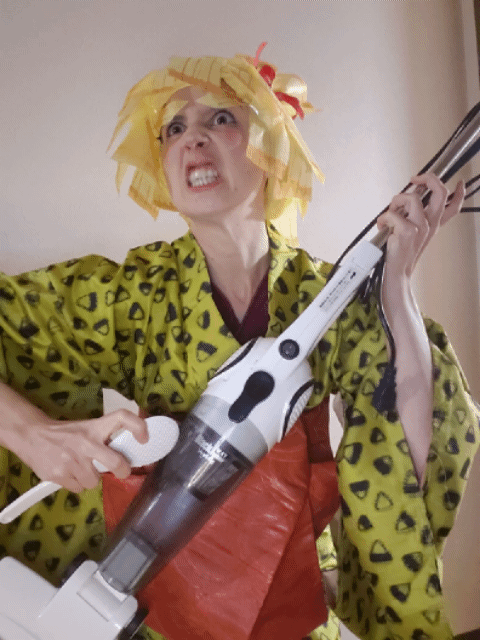
#my most labor intensive closet play yet#it used even more hot glue than the Uzui one did#KnY Closet Play#Agatsuma Zenitsu#I was already puzzling over how to do a Zenko when I stumbled upon this kimono#and get this#it's a Taisho period kimono#: D
54 notes
·
View notes
Text






Great example of everyday noragi (work clothes, worn by farmers for ex.) from Taisho period. Note the makisode sleeve shape, offering freedom of mouvement!
You can see the close-up of the weave, made from asa (bast-fiber like hemp or linen) and kamiyori (twisted paper thread). Despite its "rugged" materials, weave is delicately interlocked with regular black stripes.
The coat also presents geometrical sashiko (white quilting), both reinforcing easily worn areas (collar, hems, inner center back), and decorating the garment.
PSA for writers: please please please don't put characters doing manual labour in "silk" kimono. I'll be forever grateful ;)
#japan#fashion#kimono#fashion history#noragi#work clothes#farmers#asa#hemp#linen#kamiyori#paper thread#sashiko#Japanese quilting#taisho period#着物
328 notes
·
View notes
Text

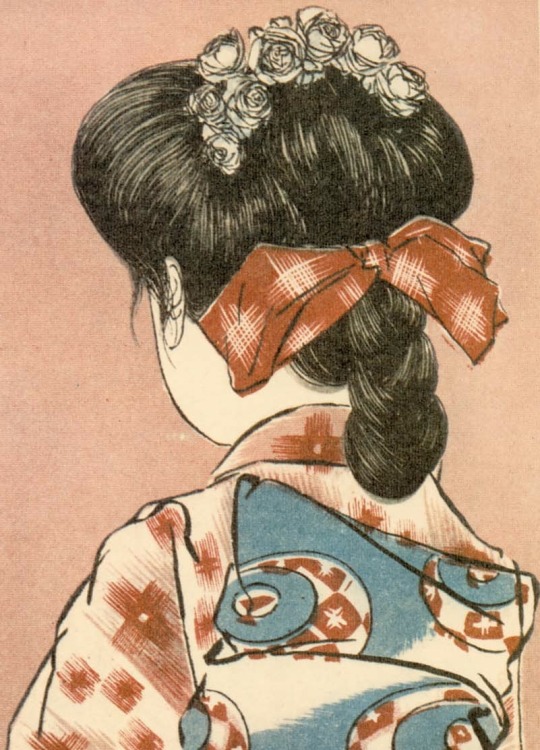
the マガレイト (magareito) hairstyle, popular among school girls and young women during the late meiji to early taisho period
#meiji era#meiji period#meiji restoration#taisho era#taisho period#kimono hairstyles#japanese hairstyles#historical hairstyles#japanese illustration#japanese art#writing moodboard
216 notes
·
View notes
Text
sometimes newspapers are good for something

#meguro and mio are very cute together im so excited for the movie#them arriving at the special event screening red carpet in a taisho period car dressed in kimonos...#slay moment right there
0 notes
Text
Kokushibou on White Day
a/n: set in Taisho period (I know there was no White Day or Valentine's Day back then but there is now), here demons can eat human food
+ You confessed to Kokushibou one month ago. To say that he was surprised was an understatement. Even though you just gave him some chocolates, he was touched and flattered.
+ While talking to Akaza, he found out that if he accepted confession chocolates from someone, that he would have to give back to them one month later.
+ Kokushibou didn't mind. At first, he only talked to you sometimes out of curiosity -- why would a human meet up with him, the Upper Moon One, at night, and be completely unafraid of him? But since your confession to him, the two of you started seeing each other more often, and he grew very fond of you.
+ He was a bit overwhelmed at having to get together some gifts. This custom was unfamiliar to him, and it made his head spin a bit. He has troubles getting used to how the world changes over time.
+ Akaza gave him a list of things to buy I mean steal to give to you. Chocolates, marshmallows, body lotion, and lingerie.
+ Kokushibou was not going to give lingerie. He viewed giving lingerie as something very inappropriate. He would feel like a pervert if he gifted you something like that.
+ He went to meet you at your usual meeting spot in the forest. He arrived before you did (as was usual) and awkwardly stood there holding the bags of things he got for you.
+ His hands were shaking a little. He was worried that you would be unsatisfied with what he got you.
+ As much as he tried to steady himself, he couldn't. He was still so nervous.
+ When you arrived, Kokushibou's body got stiff. It was like he wasn't even breathing. You walk up to the 6-eyed demon, noticing the bags he was holding, and confused at his tension.
+ "Kokushibou, are you all right?" you ask him. His body jitters a little and with a stiff jaw, he says, "Yes." He clears his throat and holds out his arms, awkwardly pushing the bags to your chest. "I ... this is ... for you ..." He starts to blush.
+ You are kind of overwhelmed by how much he got you. You smile and take the bags. "Can I see what's inside?" you ask him.
+ He nods stiffly and watches as you place the bags on the ground and sit down with them. As you start to look through what's in the bags, he kneels on the ground and presses his fists into his lap.

(art from grape27.lofter.com, non-commercial reproduction is allowed)
+ Inside one of the bags are many kinds of chocolate, marshmallows, cookies and candy. Inside the other one is a bunch of skincare lotions, creams, and a white kimono with red flower patterns on it.
+ You look at Kokushibou. "Thank you for this," you say. "I can't believe you went through all the trouble to find these gifts."
+ His body relaxes some. He smiles a little. "I'm glad ... you like it ..." He sighs very softly out of relief. He pauses for a moment and then gets up to sit next to you.
+ When he sits next to you, you take one of his hands and hold it tightly. He breathes a sigh of relief and holds your hand back.
+ Both of you are both looking towards the bags. Kokushibou is too shy to make a move and you aren't sure whether or not it would be too much for him if you give him a kiss.
+ "Ehm ..." Kokushibou then says. You look at him. "Do you mind ... if we ... share ... some of the sweets here ...?" He squeezes your hand a little tighter. "I'm sorry ... I shouldn't ask to ... share ... your gift ..."
+ You smile. "It's fine. You got me so much here, I don't know how I can eat it all." You reach inside and take out a pack of marshmallows. "Especially these. They won't stay soft forever."
+ His interest is perked. "Soft ...?" he asks. You laugh. "Yeah. Do you want to try?" He nods.
+ You then learn that Kokushibou likes marshmallows because they are soft and sweet.
+ The two of you eat some of the candy, Kokushibou eats too many marshmallows, and you enjoy your time together.
#kokushibo#kokushibou x you#kokushibou x y/n#kokushibo x reader#kokushibo kny#kokushibo fluff#kokupuffs
318 notes
·
View notes
Photo


Han-Juban
Taisho period (1912-1926)
A silk under-kimono garment featuring a faux-shibori-patterned cotton body, and shibori silk sleeves
174 notes
·
View notes
Note
Hello! I was wondering about the evolution of kimono styles throughout Japanese history. I have a rather static image of what they look like, but being into general historical fashion made me question if it really was as unchanging as I imagine. For example, the Edwardian and Victorian silhouettes, or Tang dynasty qixiong and Ming dynasty aoqun look very different from each other. Did kimono have they own trends that amateurs don't know about?
Part 2: Hi, just to clarify, I mean general fashion trends, for both men and women (though I'm leaning more women). Also, I was wondering if there was a disparity between geimaiko trends which separated them from "normal" women. In certain cultures, courtesans and entertainers were trendsetters.
The kimono as we know it today, the kosode, has been around for approximately 600 years or so. In that time not much has changed in its shape, but rather all changes have been made in length and material. Until the late 19th century almost all kimono were worn while dragging along the floor, so they were longer than their contemporaries. In terms of material, obviously the richest members of society had the most lavish kimono, which are the ones that have survived in the highest quantities to this day. From what we know as the "modern kimono," which dates to the Edo Period (1603-1868), we know that goshodoki (views of the nobility) were a very popular motif on kimono for both women and younger girls (kosode and furisode) and were worn on their best kimono. Goshodoki began to fall out of favor just before the Meiji Period, so around 1840-1850, when Japan began to experience upheaval and Western influence.
When it comes to influences and influencers, The Edo Period once again strictly controlled what people could wear due to sumptuary laws. There were many ways that people got around these laws, but for the most part you had to dress in what was prescribed for your social class. Courtesans were in a class above those of the "normal" people, so they weren't setting any trends for clothing (although they did with their hair). However, it was the geisha who were trendsetters for the common people as they belonged in the same class. What a popular geisha wore was quickly copied by other geisha, which was then in turn copied by townswomen. The only real control that they had over their wardrobe were the patterns on their kimono and obi, which, although still regulated, could be presented in unique ways or new color patterns.
With the end of the Edo Period came the end of sumptuary laws and a fair degree of Western influence in everyday Japanese life. Kimono were now shorter as people no longer wore them dragging on the floor (except for geimaiko) and motif placement had to change to due to the adoption of Western furniture. Kamon (family crests) on women's kimono grew smaller but with them came added motifs on shoulders that weren't seen before as now most motifs on kimono couldn't be viewed properly on Western style chairs. Western style motifs and artistic styles also began to be adopted in the early 20th century in a time known as the Taisho Roman. Kimono production boomed during the Taisho Period (1912-1926) as Japan was expanding its foreign territories and the economy soared. The different types of motifs and and the sheer richness and sparing of no expense was something that has never been seen before and will never be seen again. Sadly then came World War II, production stopped, and when it resumed it was much more subdued as people moved to Western clothing as their main clothing of choice. Kimono were still being produced throughout the 1960s, 1970s, and 1980s with a fair amount of regularity, but the burst of the bubble economy in the 1990s lead to a sharp decline in kimono production. It's only been within the last 10 years or so that a "Kimono Renaissance" has been taking place that has lead to both foreigners and Japanese nationals rediscovering the iconic garment, with an uptick in indie designers leading the way in new fashions rather than older fashion houses ^^
20 notes
·
View notes
Text



Painted Uchikake, Taisho period (1912-1926), Japan. The Kimono Gallery.
This opulent and wonderful Taisho-era uchikake (bridal robe) was obviously made by exceptionally talented artist and craftspeople, as the design and yuzen-painting are superb. This very lightweight silk wedding garment has much silk and metallic embroidery mixed with this yuzen-work. 'Hana guruma' in Japan translates in English to 'flower cart'. Historically, ox-carts also have proven to be popular decorative motifs, especially on women's textiles. Ox-carts often appear on bridal overkimono robes, perhaps drawing a parallel between the grace and elegance of the bride and the gentility and refinement thought to have characterized the lives of the nobility during the Heian Period a thousand years ago, regarded as the golden age of Japanese culture. Ox-carts, too, may have been the inspiration for the curious motif in art of the cart filled with flowers of the four seasons. Paintings and other depictions of flower carts inspired real carts for flower arrangement, not the other way around.
Courtesy Alain Truong
18 notes
·
View notes
Text
For #FrockFriday, this was definitely one of the highlights of the #KimonoStyle exhibition at The Met:

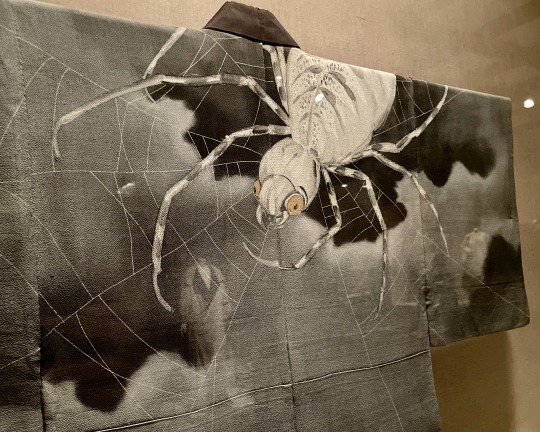
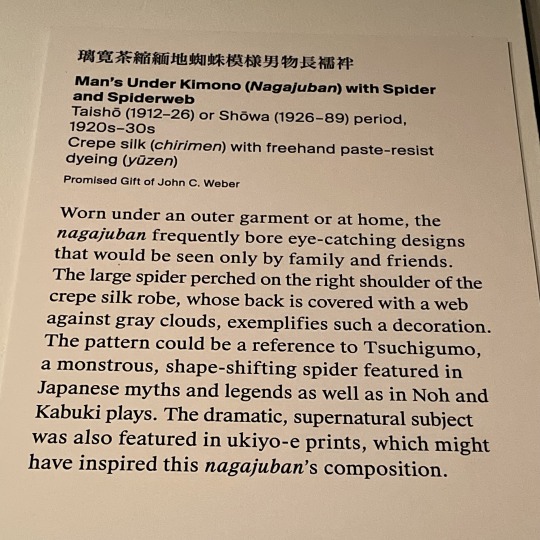
Man's Under Kimono (Nagajuban) with Spider and Spiderweb
Taisho (1912-26) or Showa (1926-89) period, 1920s-30s
Crepe silk (chirimen) with freehand paste-resist dyeing (yüzen)
The Metropolitan Museum of Art, New York
"Worn under an outer garment or at home, the nagajuban frequently bore eye-catching designs that would be seen only by family and friends. The large spider perched on the right shoulder of the crepe silk robe, whose back is covered with a web against gray clouds, exemplifies such a decoration. The pattern could be a reference to Tsuchigumo [Yōkai], a monstrous, shape-shifting spider featured in Japanese myths and legends as well as in Noh and Kabuki plays. The dramatic, supernatural subject was also featured in ukiyo-e prints, which might have inspired this nagajuban's composition."
#spider#arachnids#invertebrates#Japan#Japanese art#East Asian art#textiles#historical costume#kimono#nagajuban#Noh#Kabuki#Yōkai#Tsuchigumo#Japanese mythology#Japanese folklore#20th century art#1920s#1930s#Metropolitan Museum of Art New York#Kimono Style#exhibition#museum visit#Frock Friday#animals in art
158 notes
·
View notes
Text
Some interesting theories about Yagasuri
Yagasuri is a pattern inspired by arrows with a symbol of aiming at a target and is an image of goodness and luck. Edo period brides are prayed for good luck to ensure they would not return to their hometown when they got married.
Yagasuri is also similar to Hamaya 破魔矢 – a type of lucky charm, used to destroy evil spirits. Yagasuri aiming at Utahime is symbolize that this is a kind of charm for her. From Gojo and towards Utahime carries the image of a lucky charm.
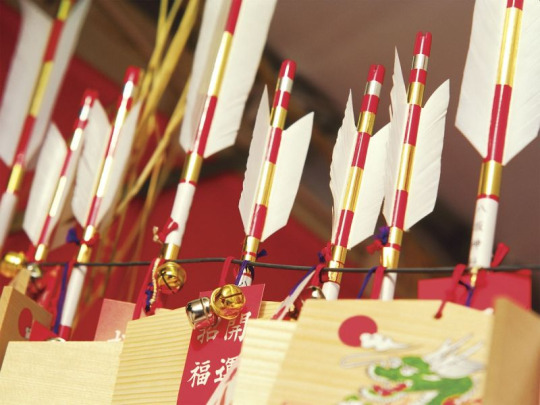
The image of Yagasuri with Miko (including kimono and hakama) will remind you of the Yagasuri Hakama - one of the traditional outfit that female students wear at graduation ceremonies.
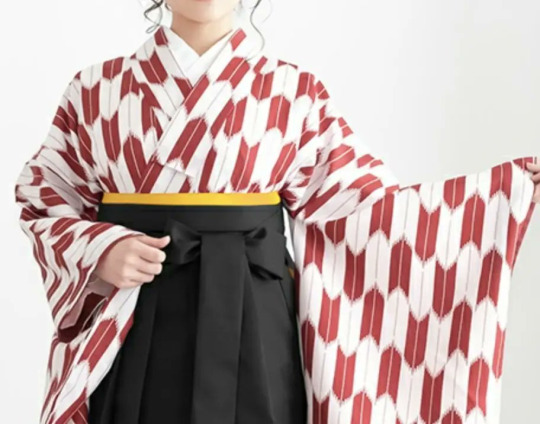
This type of traditional clothing originates from the Meiji era, where Western influences began to be introduced to Japan. Hakama and kimono, boots are the remind of Meiji and Taisho era schoolgirls.
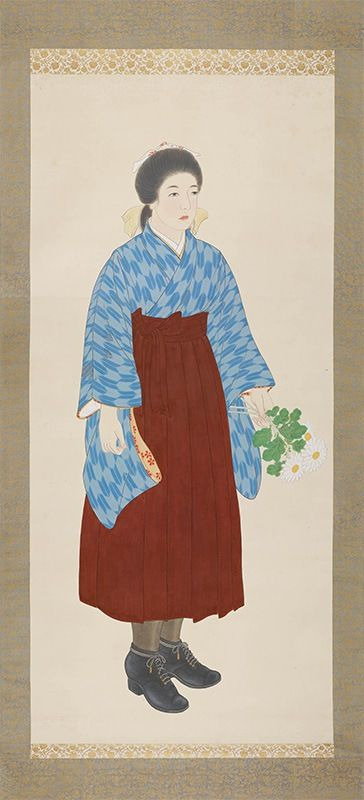
During Taisho Roman, female students wear hakama and ride bicycles and play sports. ロマン in [大正ロマン] include dream and romantic. The manga: Haikara-san ga Toru depicts women of the Taiso period which created anime, films, plays or television. The character Benio Hanamura wears a kimono with arrow motifs, a maroon hakama, black boots, and a large ribbon on her head. Yagasuri Hakama is said to be influenced by this manga and is widely popular.
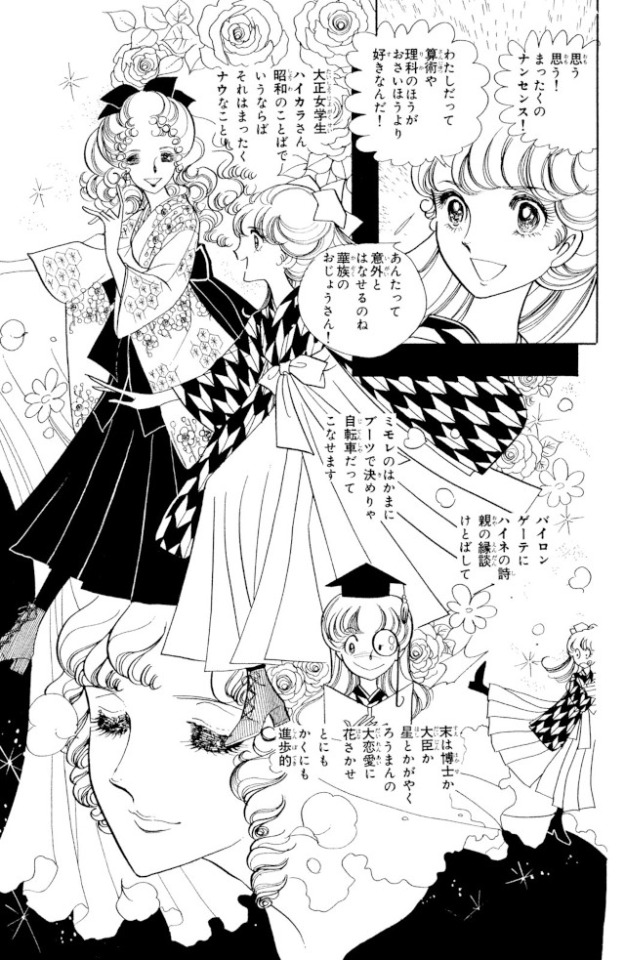
Gojo's story about returning from abroad about the blending between the West and Japan during the Meiji and Taisho eras. Meaning of 143 - "i love you" is also said to originate from Minots's Ledge since 1894 and it has also been called the most dangerous and romantic lighthouse.
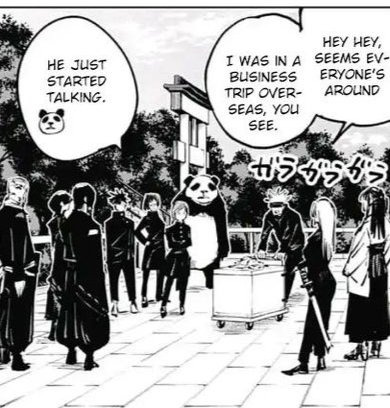
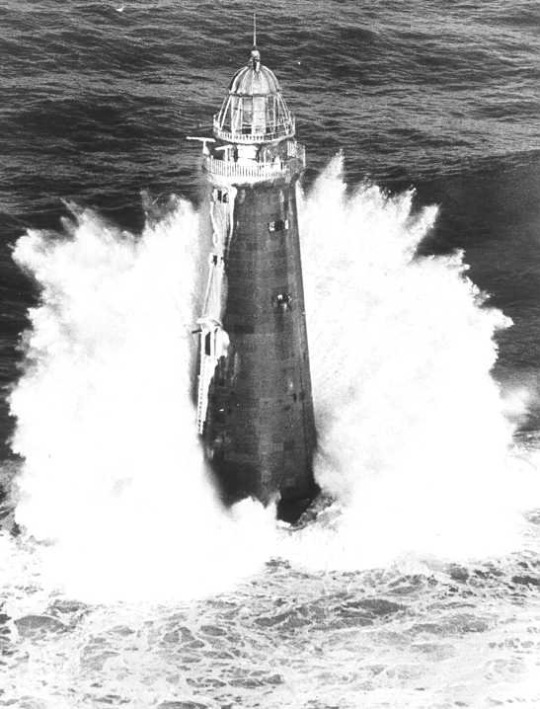
The image of an arrow pointing to the left can also be understood as a metaphor for reading from right to left and from Gojo (341 -> 143).
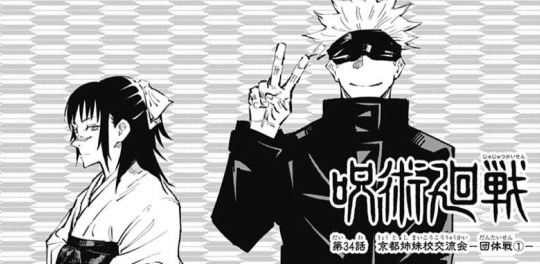
21 notes
·
View notes
Text

The story of My Happy Marriage is set in a fictitious historical time period reminiscent of Japan's Meiji and Taisho eras. How did this influence you at the time of deciding how certain scenes would be played or what traits the characters would have?

Takehiro Kubota (director of My Happy Marriage): "To be honest, I didn't really pay attention to the era when it came to the characters... (laughs). But, since many of the garments are kimonos, we paid particular attention to the patterns on the kimonos. The setting of the original story is about half-realistic and half-fictional, so the things are designed in such a way that they "look like they fit the setting" rather than being based on precise historical research — though, that's not to say we didn't use a variety of materials from the specific time period as references to strike a good balance between reality and fiction. Originally, the time period, location, and even the country were not clearly stated in the novel. It was a Japan-like, Taisho era-like, ambiguous fantasy world. So we paid close attention to finding the right balance between the realistic and the fictional."
14 notes
·
View notes
Text
Nezuko's Favorite: Konpeitou
It's time for Kimetsu Kitchen, and over-analyzing a tiny lore detail! And by tiny, I mean 1.5cm or smaller.

As already stated in the first fanbook, Tanjiro reminds us the Yuukaku Arc Taisho Secrets that Nezuko's favorite food is humans konpeitou, colorful tiny candies that are made almost entirely out of sugar. They are best known for their signature shape, with a bunch of bumps called "tsuno," that is... horns.

Aha, I see what you did there, Gotouge. So in that light, I'm not going to hold back wherever I see connections to Nezuko. First off, like Nezuko, konpeitou also comes in many fun sizes. Because of how the horns are formed with the candies bumping into each other and dripping onto the biggest protrusions, the candies have fewer and fewer horns as they get bigger.
We'll get into how they are made is a second, but first a brief history. Konpeitou, like castella and tempura, were introduced to Japan in the Sengoku period by the Portuguese missionaries. Warlord Oda Nobunaga was even presented with some earlier versions of this "confeit" that had anise at its core for a refreshing finish. However, after the missionaries were kicked out, they disappeared for a time, until Edo-period townspeople in Nagasaki (with access to trading with the Dutch) developed a pan-fried version, which they named 金平糖 (gold-even-sugar). Konpeitou were a rare treat accessible only the rich and powerful, such has the emperor using it for special occasions, until a new and easier method with rotating frying pans was patented in 1903. This was already 36 years into the Meiji period, and Nezuko would had been a toddler.
The first konpeitou factory opened in 1907 in Osaka, which is when they really took off as a wide-spread treat, including being sent abroad in soldiers' rations. The first ones were not flavored, they were purely made of granular sugar and sugar syrup (a mix of sugar and water, so yay, more sugar!), and they came in four different sizes. However, the first variations came when they made a mix of four basic colors to reflect the seasons: pink for cherry blossoms in spring, green for summer greenery, yellow for the autumn leaves, and white for winter snow.
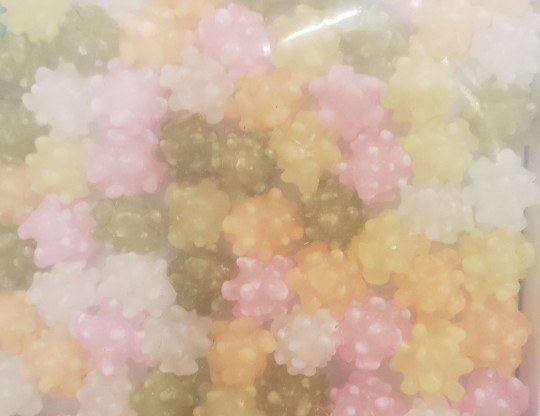
(The closest example I saw to the colors Nezuko might had had available, don't mind those orange ones.)
Throughout the Taisho period they gradually gave way to more popular sweets like ice cream and chocolates, but when Nezuko was a 12-year-old likely around 1912~1913, these would had been widely available and popular.
So how are they made today? Still mostly in Osaka, there's only about 10 factories in Japan that produce them. But only about 5 in Portugal that do, so no wonder people assume they are a Japanese invention! Although you can still find them as purely sugar-flavored and some cafes likes to use them instead of sugar or sugar cubes, you can find them in a very wide variety of colors and flavors now. Basically, if it can be dissolved into syrup, you can color or flavor konpeitou with it.
Konpeitou starts with granular sugar, turned twice a minute in tilted frying pans that are 180cm across at 75 degress C. Every few minutes it gets coated with a scrap of syrup, which gradually makes the candy grow bigger and bigger. It sounds like a simple process, but it takes a lot of patience and practice to get the precise humidity, temperature, timing, and movement to attain a translucent appearance and smooth texture with a pleasing array of horns.
If there is one character in KnY who is extremely patient and can pour that sort of effort into developing something, it's Nezuko. Konpeitou grow only 1mm per day (so it takes two weeks to make a batch of large konpeitou), but that ongoing, dedicated growth is very auspicious, like... hmm. Like what the asanoha pattern on Nezuko's kimono symbolizes. I've always assumed the vines in Nezuko's demon crest symbolized the same thing.
Alright, now to turn this into a Kimetsu Kitchen blog. If you are in Osaka prefecture, you too can join a very brief konpeitou making class to add the finishing touches to a little batch of mostly-finished konpeitou! You get to choose the flavors and colors, and for extra money, you can even add edible gold flakes or get cute jars to put them in. I got to make two batches, one based on the color and flavor already in the first batch. I was concerned out pink and green might mix, so I went with pink followed by yellow for a nice nod to Zenitsu's efforts in Kimetsu Academy to give her the perfect konpeitou. However, I wound up with a nice shade of peachy orange like her hair, and I'm sure Zenitsu doesn't mind.

I call the flavor "drink bar" because I thought a non-pick flavor like melon would be ironic and I wound up with a mix of melon and cola. It's pretty good.
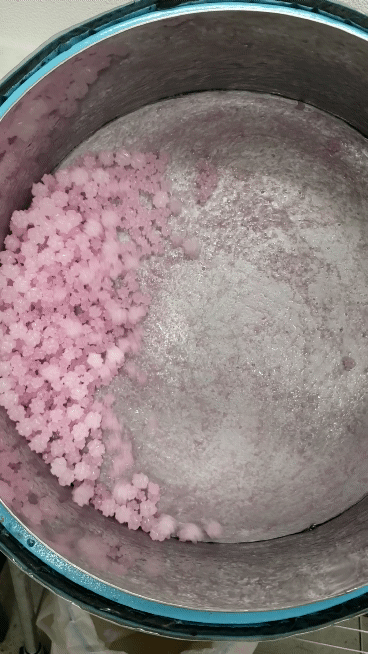

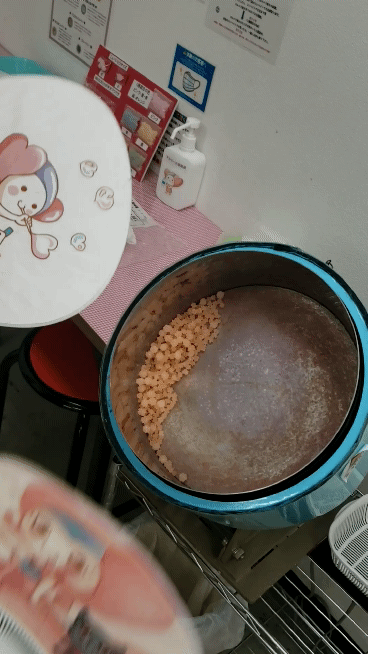
The base konpeitou was purely sugar flavored and white, but with tiny ladles of syrup with food coloring and flavor added and stirred about ten seconds at a time, the shape also gradually changed as the horns got more pronounced. It really is up to taste how little or how much you want to add, they're very versatile once the basics are formed.
104 notes
·
View notes
Note
I've been trying to write something about the Meiji era with a young woman who (EXTREMELY anachronistically I know) is a note-taker in a court of law. I cannot for the life of me figure out what a woman would wear in that situation. What are your thoughts?
Hi! As you said, the situation you describe is quite an anachronism ^^; I am not familiar with Meiji law system, but I highly doubt a woman, especially a young one, who'd have been allowed in such official position (TBH, I am not even sure "court" as you envisage it was truly a thing before very late Meiji/Taisho).
With that said, it depends of the exact time + the means of your character;
in early Meiji, go for kimono without a doubt, more or less fancy is up to you but court would be quite a formal setting.
In late Meiji, you can get a bit more leeway and add Westernized elements (but please note that full Western dress was only a thing for rich women). If you go a tad informal, go for the trademark "working" look of kimono+hakama which was very popular for girls/young women
Mitate+ has a good overiew of the period (text in French but lot of pics!) => Meiji / Taisho
I don't know if it's your reference, but maybe have a look at characters in the games of the Great Ace Attorney Chronicles serie - the Meiji era inspiration in veeery loose ;)
47 notes
·
View notes
Text
Actually, @lightandfellowship asking about other Dark Road historical fashion thoughts on this post did kind of get me thinking about it and you know what I think is really interesting? Is that there are only two students that are at any point wearing entirely Western-looking (non-Japanese) clothing without an obi and obijime, and that’s Xehanort (pre-arrival at Scala)...
And Baldr.
Even Master Odin is wearing an obi and obijime despite otherwise dressing like Gandalf, but we’ll leave him aside for the sake of this discussion.
For the most part the students are wearing fusion clothing, but that’s typical of the Taisho era. The Taisho period, which immediately followed the end of the Meiji Restoration, was a period of great change in Japan, and of Westernization. It was very common for people to wear a mix of Western clothing with traditional Japanese clothing. You can see a lot of this in the Dark Road students;
(This got really long lol. Discussion of the secondary and tertiary Dark Road students’ design choices, culminating in discussion of Eraqus, Xehanort, and Baldr’s designs and what they might mean in the context of a Taisho-period-adjacent setting, under the cut).
- Most of the male students, plus Urd, are wearing very loose, bloused pants, probably tobi trousers or karusan-bakama.
- Vidar, Vali, and Vala have some of the most traditionally Japanese silhouettes among the upperclassmen. Vidar is wearing a sleeveless lapped garment that isn’t strictly traditional, but has a very Japanese look to the way it’s assembled and to the color styling, while Vali is wearing pretty authentic-looking Japanese faulds, and is obviously supposed to make you think of the kabuki ideal of a ninja. Vala also looks EXTREMELY Taisho-period; the wearing of silk-painted or embroidered, brightly-colored hakama with an obi and furisode or kosode was extremely common for girls in the Taisho period. Vala has some sort of fantasy puff cuff-sleeve-thing instead of furisode, but her hakama and obi are lifted straight out of the 1910s. Interestingly, these upperclassmen, like Eraqus in the lower class, survive the longest.
- Heimdall, Sigrun, and Bragi are all wearing a mix of actual traditional Japanese clothing and Western elements. They are all wearing short kimono, with Sigrun having a very classic obi styling, Bragi is wearing traditional workman’s clothing (a hanten and sarubakama, with an obi without obijime, interestingly), and Heimdall appears to be wearing a kosode, with obi and obijime. However, Sigrun is wearing leggings and gaiters, Heimdall has some WILD thigh-high Three Musketeers boots and that very intensely high-collared, French-looking bolero jacket, and Bragi is, as previously discussed, wearing a bomber jacket (and also Chuck Taylor sneakers, Bragi you sneaky, deeply anachronistic guy).
- Helgi and Hoder, interestingly, appear to be blending Japanese and Chinese clothing styles; they’re both wearing obi and obiage, but Hoder appears to be wearing a cheongsam, and while Helgi is wearing a sleeveless kimono as a shirt, his fur ruffs very much evoke some traditional theatrical depictions of Son Goku (the Monkey King not the DBZ character); but I’m not that knowledgeable about Chinese clothing so I won’t make too many conjectures here.
- Urd and Hermod and Vor all have very fantasy-like designs, with the girls having fewer garments from either real Western or Japanese styles. Hermod and Urd as discussed have the bloused pants, Vor’s coat looks VERY much like a traditionally silk painted kimono that’s been altered to have a Western tab-collar, but has a traditional Japanese rope bow on the back, and all three are wearing obi and obiage. However, Urd’s robe/cape thing is VERY Western Fantasy Wizard, meanwhile Vor is wearing actual pumpkin pants. Hermod’s looks the most period, with his haori retaining the traditional lapels but altered to have Western bishop sleeves, and he’s wearing VERY WWI-style gaiters.
Now lets talk about the other three, who are actually our main characters; Xehanort, Baldr, and Eraqus.
Eraqus is absolutely wearing nothing but traditional Japanese clothing (aside from the obvious Kingdom Hearts elements of the turtleneck and crossed suspenders). He is wearing extremely traditional hakama, with the most traditional haori of any of the cast. His hair is partially loose but what is pulled back is pulled into something like a topknot; Eraqus is designed in every way to evoke the look of the samurai class. What I think is significant with that is that, as mentioned, the Taisho period followed the Meiji Restoration, when the samurai class in Japan were more or less disbanded in the face of modernization of Japan. I don’t think it’s unrelated that at this point, the Scalan society that considers Eraqus a ‘blueblood’ is also in decline, and is ultimately ended within Eraqus’s lifetime. He is the last of his kind, and he is dressed like it.
Then, there’s Xehanort. When he leaves Destiny Islands to go to Scala he’s dressed in an outfit that calls to mind Ephemer’s, and is extremely Western and modern-looking; which makes sense, since he was raised by Player, and the KHUX time period has very modern and Western fashion (remember Bragi’s Chucks?). But once he’s a student, he’s replaced his button-down shirt and collared sleeveless duster with a turtleneck (Kingdom Hearts, lol) and haori of his own, an exact photo negative of Eraqus’s haori except that Xehanort’s is sleeveless. But Eraqus is a blueblood, and as far as anyone in Scala knows, Xehanort is a nobody and a foreigner; he is still wearing Western pants in a Western style, held up by a Western belt and without any obi in sight. Xehanort was born in Scala, and he resents being seen as Just Some Guy, but he doesn’t belong there like Eraqus does; his haori on top is trying to make him part of that world, an equal to Eraqus, but what’s underneath reflects that Scala doesn’t consider him either of those things.
And then, there is Baldr.
I’ve seen other posters point out that his clothing is all black, under a white jacket (I’m sorry I don’t remember who pointed this out!), but also, Baldr has the most Western and contemporary clothing of all of the characters in Dark Road. In contrast to Xehanort, with his loose, pre-WWI-era jeans, Baldr is wearing contemporary skinny jeans with a wallet chain and fashionable low-buckled boots. He’s also wearing a waistcoat, and a bolero jacket with what looks like knit cuffs. He doesn’t fit in with the others at all, even less than Xehanort does.
And pointedly, like Xehanort, he is not wearing an obi.
I feel like it’s not a coincidence that this game visually sets its characters in the Taisho era, the time period that transitioned Japan from the traditional Japan to the modern, Westernized Japan of the 20th century, and the character who puts a permanent end to Scalan society is the only character dressed entirely in Western and modern clothing. Obviously I can’t say for sure what the intent was, but at the end of the game, the three characters left standing are Eraqus, dressed in the most traditionally Japanese fashion, Baldr, dressed in the least, and Xehanort, the fusion, who is dressed like Eraqus on the surface, but underneath, is dressed like Baldr.
#KHDR#Kingdom Hearts#Kingdom Hearts Dark Road#long post#related to; fashion history#In case this seems like talking out of my ass lmao my qualifications are I have a degree in fashion#with a focus on fashion and costume history#did my final graduating paper on how modern Japanese street fashion#was influenced by Meiji and Heian and Taisho fashion#and also worked as a professional costumer for the theater industry for several years#Butttt it's been a little bit so there may be inaccuracies#but these are my thoughts from like. A costume design perspective and how costumes inform character for narrative purposes
35 notes
·
View notes
Note
Hi, as someone somewhat knowledgeable on kimono and kimono history, re: Cater's New Years card: Nagajuban is the name of a kimono undergarment, not the shirt. And the shirt is just as much Meiji and Showa as it is Taisho. And the coat is haori. Haori predate the Taisho era by many eras and are still a part of many kimono today. Haori are not a specifically Taisho thing, they have always been present in kimono and still are.
[Referencing this post!]
***Content warning: discussion of war and imperialism!***

Hello, and thank you for sharing your knowledge with us! ^^
Yes, I’m aware that nagajuban refers to a kimono undergarment! In my original post, I meant that Cater’s shirt resembles the cut of a nagajuban while not explicitly being one, not that the nagajuban itself is a kind of shirt.
It’s interesting to know that some aspects of fashion greatly predate the era that a lot of people closely associate with a particular look, or that aspects of it still exist in modern fashion today. I think that speaks to how flexible and dynamic clothing can be. As much as we may think of it as being “from X part of history”, it’s not like it just popped up one day and became the dominant fashion; like most things that occur over a long period of time, trends in attire are gradual and ever changing.
This is partly why I take the stance that I do regarding “problematic” fashion and why I (someone whose family was impacted by Japanese imperialism) don’t take offense to Cater’s “imperialist Taisho era” dress; because what is “in style” often changes and adapts, and trends rise and fall, I don’t think it is meant to strictly represent specific periods or even certain attitudes. There isn’t always meant to be series intention or an agenda behind the dress; sometimes it’s just a result of how looks evolve over time or a look that has become such an integral part of one’s culture and history that it’s impossible to separate it from the country itself. (Another example would be how Japan’s sailor fuku school uniforms are modeled after navy uniforms, which alludes to war time, yet we still so often see sailor fuku in innocent anime like of the magical girl genre and in some real life Japanese school settings.)
I know that TWST now has a localization, but it is originally a Japanese game. We should expect to see Japanese fashion in it, especially components which have become so quintessential to even synonymous with, its own history and culture. We should be cognizant of this fact while also holding onto an awareness and a respect for those who feel uncomfortable about the clothing regardless. As I always stress, topics like this should not be an “I’m right, you’re wrong” kind of thing. Let’s keep the dialogue open and be willing to listen to others and empathize with their thoughts and opinions.
#twst#twisted wonderland#disney twisted wonderland#Cater Diamond#notes from the writing raven#tw // war#tw // imperialism#advice
44 notes
·
View notes
Text


Woven kimono
Taisho period (1912-1926)
A silk kimono featuring woven geometric on flower motifs. Fine, high-quality silk, with a complex weave (see detail image
119 notes
·
View notes